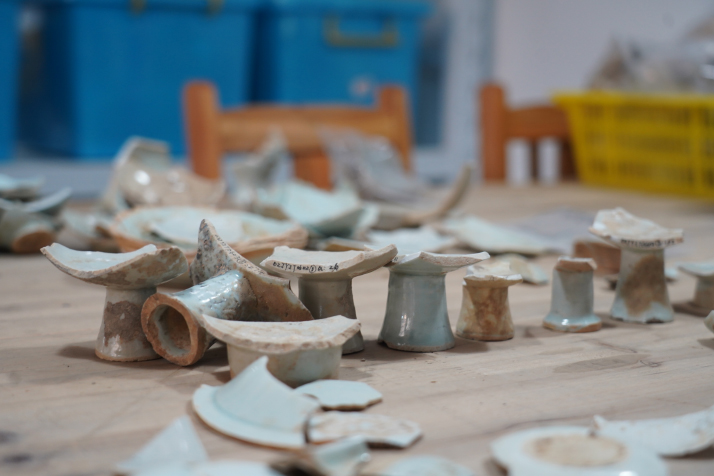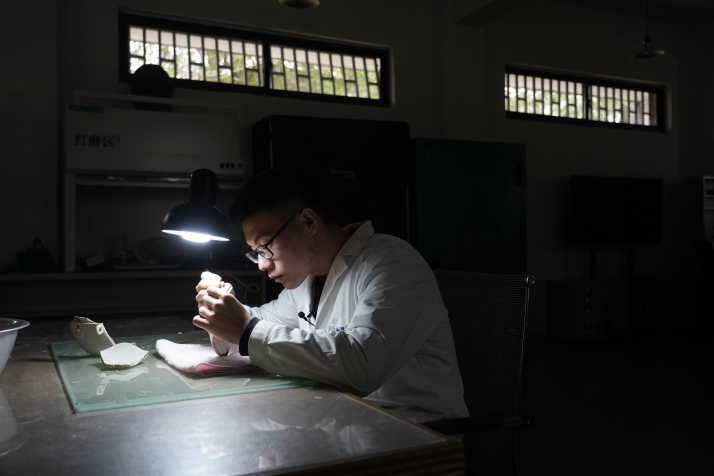| Lifestyle |
| Reviving tradition in China's capital of porcelain | |
|
|
 Porcelain pieces from the restoration department of the Imperial Kiln Museum in Jingdezhen, Jiangxi Province, feature detailed serial numbers (XINHUA)
When Xiong Zhe is on stage playing the cello, it's hard to imagine that his daily job is to analyze the molecular structure of ceramic relics of different ages at a research institute, almost equivalent to genetic testing and creating a gene bank. The 31-year-old is head of the cultural relic restoration department of Jingdezhen Imperial Kiln Museum in Jiangxi Province, as well as founder of the Jingdezhen Four Seasons Porcelain band. Xiong and his fellow band members do not use porcelain as the raw material to produce entire instruments, but they do use it to reproduce parts of the instruments—while adding Western instruments like the contrabass to the band. "It is a kind of fusion," Xiong said. "People always describe traditional Chinese music as Xianyue piao piao in Chinese, meaning 'the flowing music for gods and goddesses'," he told Beijing Review. "Chinese porcelain has a characteristically bright timbre. If you add a bass, the effect will be perfect, and the traditional folk music will take on a new sound." When the band, composed of a guzheng (Chinese zither), cello, bass, porcelain drums, porcelain bowls and other instruments, performs Shimian Maifu (Ambush From 10 Sides), a masterpiece of classical Chinese music, the melody and ceramics produces a fascinating harmony, one in which the old and new converge. This is where tradition becomes trendy. "The most important value of the platform is to help younger generations understand and inject their thoughts into a tradition that has been passed down for thousands of years," Xiong said. Echoes of history Jingdezhen lives and breathes porcelain. It began producing pottery during the Han Dynasty (202 B.C.-A.D. 220) and porcelain about 1,700 years ago, with its local artisanal craftsmanship rising to prominence during the Song Dynasty (960-1279). The city's culture of ceramics continues to this day. In elaborate forms and enabled by sophisticated techniques, the art of Jingdezhen porcelain-making is widely recognized as a gem of the age-old Chinese civilization. Some even believe Jingdezhen to be the birthplace of the word "china." As Chinese ceramics and porcelain in days of yore served as diplomatic gifts for trade, today, they brave borders, cultures and times alike. Among the hundreds of thousands of kilns in the ancient city, the Imperial Kiln, Yuyao in Chinese, was a specialized workshop that moulded, fired and supplied ceramic pieces for the imperial families of the Ming and Qing dynasties (1368-1911). Now preserved as a museum, the biggest highlight here is that most of the artifacts have been repaired with the meticulous application of matching damaged porcelain pieces unearthed from the Imperial Kiln factory. From 1982 to 1994, the Jingdezhen Municipal Institute of Archaeology conducted several archaeological excavations on the Imperial Kiln site, and unearthed "tens of tons and hundreds of millions of pieces" of imperial porcelain from the Ming Dynasty (1368-1644). Why are there so many pieces of imperial kiln porcelain buried deep in the ground? The firing of porcelains for imperial use was a complicated process of trial and error, resulting in the limited production of fine-quality products. "To prevent them from reaching the common people, the extra fine products would be smashed and buried on the spot," Weng Yanjun, curator of the Jingdezhen Imperial Kiln Museum, told Beijing Review. These "trash-to-treasure" pieces buried deep in the ground provide the contemporary world with the ability to interpret the ancient ceramics firing process, their raw material formulas and other "genetic codes." But there's more. The complete ancient ceramic wares of the Imperial Kiln are valuable pieces of history, and the handed-down collections are of extremely high aesthetic value. Unfortunately, from a research perspective, their number is limited so literally breaking down a complete ware for research is a no-go. "The ancient ceramic fragments are more conducive to technical testing," Weng said.  A restorer repairs ceramic ware at the Imperial Kiln Museum in Jingdezhen, Jiangxi Province, on December 3, 2020 (XINHUA)
A modern transition Over the years, with its unique ceramic archaeological and cultural preservation resources, the museum has cooperated with several domestic and foreign institutions for academic exchanges and archaeological collaboration. On this cooperative basis, it has accumulated nearly 20,000 pieces of ceramic analysis data from more than 10 kilns, establishing an initial scientific database of China's ancient ceramics. Today, a new generation of inheritors makes it possible for ordinary people to enjoy the beauty of this once imperial exclusivity. Inside the museum, a group of young cultural relic restorers use their finest skills to mend the broken pieces of history and bring the antique ceramic ware back to life. More than 20 young people engage in the restoration of cultural relics here—most of them are born in the 1990s. Cleaning, classifying, counting, bagging, photographing, drawing and weighing thousands of boxes of porcelain fragments excavated from the archaeological site of the Imperial Kiln factory, creating a large database and drafting archaeological reports are the daily undertakings of these young restorers. Xiong, the porcelain music performer mentioned earlier, is one of them. "What is restored is not only the porcelain itself, but also a moment in time, a piece of history," Xiong said. The museum has established an ancient ceramic gene bank based on advanced technology. The first one of its kind, this bank plays an important role in creating a better understanding of the ancient factory's development, including its surrounding kiln sites, and promoting research on the evolution of Jingdezhen's porcelain-making technology. A broader stage The city has never lost touch with its porcelain history. Porcelain runs through its veins, and locals have passed down their crafty skills through the generations to create world-class wares. But despite its reputation, the area once went into decline. Workers were laid off, and factories closed one after the other. More than 60,000 technicians and workers left the city and moved to other porcelain-making areas in the late 1990s and early 2000s. As a city that relies on porcelain, Jingdezhen fell into a recession. To continue the hand-made porcelain tradition or shift to construction and bathroom ceramics like in the coastal areas was a tough choice for the city to make. Around 2011, the local government invited global urban planning experts to help carve out a path for the city's future. The abandoned factories have since been turned into incubators that attract capital, information, technology and talent. Taoxichuan, where 22 old workshops of different style structures and kilns were located, was transformed into an art zone, creating an artistic community where over 5,000 young people now live. Today, more and more people are coming to Jingdezhen to pursue their dreams of creative greatness. Xiao Xuefeng, director of the city's Sanbaopeng Art Club, is one of them. He pins high hopes on the commercialization of Jingdezhen's unique culture. "The porcelain making tradition and culture have remained uninterrupted over the past millennium. This is what porcelain lovers around the world pay tribute to," Xiao told Beijing Review. "Jingdezhen should be an art center for the world," he added. "We don't expect the ancient city to be a crowded scenic spot, but a paradise for craftspeople, designers and artists," Xiao said. "And this is our way to protect and inherit the porcelain culture," he added. And not just that—young artists from all over the country are heading there. For centuries, the most coveted porcelain from China came out of Jingdezhen's workshops, fashioned from clay smoothened by trained hands, fired in kilns and then transported across the globe. The works, notably the blue-and-white vases and jade-green celadon bowls, graced the royal courts of the Britain, Persia and France. This was one of China's first globalized commodities and greatest export to the world. And today, the world gathers in the ancient city. Global young artists here have a famous name: jingpiao, or "floating population in Jingdezhen." According to Xiao, 30,000 jingpiao currently reside in Jingdezhen, including 5,000 from overseas. "Jingdezhen is still the world's ceramic innovation and exchange center," Xiao said. "The revitalization dream lives in the hearts of the Jingdezhen people," he concluded. Printed edition title:Return and Revitalize Copyedited by Elsbeth van Paridon Comment to taozihui@cicgamericas.com |
|
||||||||||||||||||||||||||||
|
